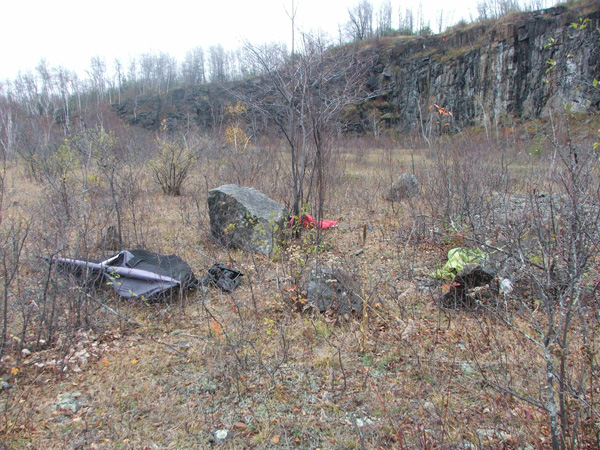A trip to Quarry Park




The parking lot for Quarry Park is located at the top of 59th Avenue West, above the railroad tracks. The lot has recently been built up with gravel, but it’s still slanted. When I visited on October 31, a third of the lot was wet from water seeping down the hillside, and a runoff gully had eroded through the gravel, serving as a giant speed bump for vehicles entering the lot.
The short trail from the parking lot to the quarry is greatly improved. The work, which was carried out by volunteers with the Duluth Climbing Coalition, wrapped up in October. A trail that used to be narrow and overgrown is now a wide, graveled corridor. The worst section of trail in the old days was a giant mud hole that required an inconvenient detour through the brush to navigate. Now it’s gone, filled with boulders, covered with gravel and graded into a broad promenade that slopes down through the woods to the floor of the quarry. Very much improved, indeed. According to the city, it’s ADA-accessible. I felt like I should be twirling a cane.
The city council formally established Quarry Park on May 9, 2016. Before that, the place was informally called Casket Quarry, though not for any gruesome reason. According to an account published on the website duluthclimbers.org, the name Casket Quarry dates back to the 1970s, when people began to climb the sheets of ice that form on the quarry’s walls in the winter. A manufacturing facility located next door to the quarry produced concrete burial vaults, which were often stacked along the railroad tracks. Climbers began referring to the quarry as Casket Quarry.
“Although ‘Casket’ Quarry may reinforce stereotypes about the perceived risks of ice climbing, among climbers the name has always been applied tongue-in-cheek,” states the website.
Today, what appear to be three heavy steel covers or lids are laid out neatly next to the new trail, as if on display. I have never seen them before. They were undoubtedly uncovered by the trail building. Given the site’s history, it seems likely that they could be burial vault lids. When I spoke with Lisa Luokkala from the city’s parks department, she confessed to being unaware of the metal lids, as she had not yet visited the new trail.
The city acquired the land for the 30-acre park from the county (for free) and from neighboring Oneota Cemetery (for $54,000) in 2015. A consultant was hired; a mini-master plan was developed that explored Quarry Park’s ice-climbing potential. It was proposed that the natural ice formations at the quarry be expanded by collecting and pumping in water and “farming” ice along more of the cliff. A disc golf course was also proposed, as was a mountain bike (excuse me, multi-use) trail up one side of the quarry and a hiking trail up the other. Luokkala said the Climbing Coalition had commissioned Barr Engineering to do a study to see how they could best pump and store water for the ice-farming system.
I commented that the Climbing Coalition seemed to be closely involved with many aspects of the park’s development. Luokkala agreed. “They’re going to be the managers of the ice climbing facility,” she said.
The new gravel path ends on the quarry floor. From there on in, the walking consists primarily of broken rocks rolling under your feet. If you’re walking along and admiring the sheer hundred-foot walls of black gabbro stone that surround you, you’ll most likely fall and hurt yourself at some point. The mini-master plan calls for an ADA-accessible loop trail on the floor of the quarry, but that development has not yet occurred.
The quarry has been inactive for decades. Little grows there but weeds and stunted trees and enormous stone fire rings. One fire ring showed signs of recent use—freshly crumpled Busch cans. Sloppy red graffiti spray-painted on a large uncrushed boulder advised me to: “Leave now! Or don’t.” There is no shortage of graffiti in the park, both historic and new. “Ain’t no thang but a chicken wang,” declares a message on the east rim trail.
With the exception of the trail from the parking lot, none of the planned trails are built yet. To get a bird’s-eye view of the park, I followed the unofficial trail that goes around the rim of the quarry, starting on the west side. This trail is deep and well-defined; clearly, it has been here for years. In places, it passes scant feet from the edge, a screen of weeds or a spindly bush all that stands between a person scrambling up the hill and a hundred-foot drop to the rocks below. I am not a fan of heights when there is a chance I might fall off them, and this stroll made me uneasy.
Luokkala told me that the rim trail was an informal one that the city did not plan to maintain. The pipe for water farming will run along the edge of the quarry, but the new trails for bikes and hikers will follow less steep, less dangerous routes to the top.
After the climb, one reaches a clearing. In one direction stretches a great vista of West Duluth. In another, a short spur trail climbs up through the woods to Skyline Parkway. The rim trail continues along the edge of the pit with various degrees of precariousness, until it arrives at the high point. Two bars of historical iron are stuck in the rock at this location, their purpose unknown. The view is spectacular. If you lie on your stomach and push yourself forward until you’re looking over the edge, you can catch a sweet vertigo rush.
The east rim of the quarry is brushier than the west, with dense honeysuckle and buckthorn thickets stabbing you and trying to push you off the edge. There are also more tripping hazards than on the west side, mainly knobs of roots sticking up out of the trail. But I survived the trip down, somehow, and eventually found myself back on the quarry floor, where I discovered more enormous fire rings and an abandoned campsite with a tent, rain fly and sleeping bag moldering on the ground.
That was my trip to Quarry Park. As the quarry is now a public park, fire building and camping out are prohibited, though such traditional activities will undoubtedly continue until the park becomes more established and some level of enforcement exists.